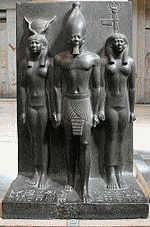Tarotcard 6
|
Card 6 But both women in the picture are well clothed and show the veiled back or the veiled front. The physical forces (lower ~ 'Shaktis'), which first on card 10 develop into 'Ida and Pingala' (and the wheel), and later at step 12 into the two pillars, ie. spirituality and vitality (like the 2 freemasionary pillars Jakim and Boaz), have now reached a certain fundamental standard. This higher form of Cupid(Kama) does not stand on the floor. He symbolizes here the spiritual wishes. His arrow is directed on the heart of the young man who crosses his arms across the breast. The chela can now span the bow like Rama in the Ramayana. But the heart is first cleaned on step 8.
This card is often interpreted as the choice between good and evil (Choice of grace) or between a sensual woman (or life) and a spiritually oriented woman. But this already happened at step 4 ! |
|
|
The Pharao stands between Hut-Sekhem (Hiw, Sistrum) and Hathor, as indicated in the Pyramid. |
Many ancient thinkers upheld the eudaimonist axiom. A very common ideal associated with the goal was the self-sufficiency (self-sufficiency of the Stoa). A characteristic of the good life was, that one does not hope for "happiness" from external factors, but finds it in oneself through one's own behavior. It was expected for all situations an unshakable peace of mind. She stood for Areté (virtue). The opposite pole was the earthly bliss Eudaimonie. |
of Spirituality
universal-path.org
